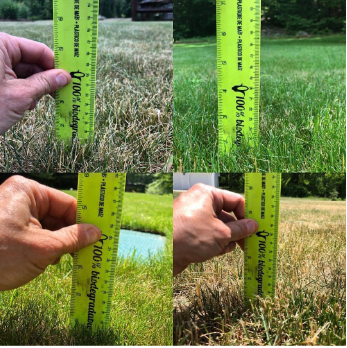Three Management Mistakes that are Killing your Lawn and Promoting more "Weeds"
The key to holistic lawn care success is good management. If you follow the two basic lawn commandments without fail-- watering deeply and infrequently and mowing tall -- then no need to read further. If you’re not quite sure how to execute those two principles of holistic lawn management, or suspect you may not be executing them correctly, then check out these three common mistakes that many folks have been making this summer. It’s not too late to improve!
1. Mowing too Short
The short and simple rule is this: let your grass grow to 5 inches and then cut it down to 3.5 inches. The full instructions can be found here. If you are cutting your grass shorter than 3.5 inches, you are destroying your turf’s root system and allowing “weeds” easy access. We know it can be tempting to cut your lawn so it looks like the green at Augusta, but resist! Your roots, microbes, water bill and lawn will thank you.
We often hear, “But my mower is set at 3.5 inches. I must be doing it right.” Unfortunately, those settings are notoriously inaccurate. Even if yours is one of the magical few mowers that gets it right, chances are your lawn isn’t 100% perfectly level. Every time a tire goes in a dip or you mow over a bump, some of your lawn is being scalped and your roots will be damaged as a result. Over time, you’ll start to notice weak spots where “weeds” will begin to take over.
A good ruler is an investment worth every penny. These lawns were all cut too short, which is sadly very common.
How can you fix this and avoid damaging your lawn? Mow a few strips in your yard and get a ruler out there. Push it firmly into the ground and make sure there are no blades of grass shorter than 3.5 inches. If your grass isn’t at least 3.5 inches everywhere, raise the mowing deck height and mow more strips. Repeat until you have it dialed. Make sure to take multiple measurements and look for spots that could have bumps or low spots. If you can’t raise your lawn mower high enough to mow tall, consider buying a new lawn mower or hiring someone who has the right equipment.
2. Watering Poorly
The short and simple rule here is this: water deeply and infrequently. The basic instructions can be found here and I go into further depth here. Watering deeply and infrequently is critically important to developing deeper root systems, having healthy soil microbial function and community, using water effectively, and reducing “weed” pressure.
This section has not been getting proper water coverage all summer and look who moved in…
Make sure you understand and audit your system and don’t be afraid to become a student of your irrigation system. We are all tiny ranchers. Every system is different and you want to manage yours as well as you can. Some are installed well, others are installed poorly, and some were installed well but were not properly maintained. If you go by the minutes on the chart without auditing the system with sprinkler cups, then you could be over- or under-watering. You may also have sandy soil sections and clay soil sections or steep hills and low spots. All these factors require further tinkering.
Also remember to check for coverage issues. If your sprinklers are missing a spot -- maybe a head got hit by a mower, or a bush that grows quickly in the spring now blocks part of the stream -- you might not notice until later in the summer. Deep rooted “weeds” will take over in those areas more easily. If you fail to deal with these issues now, you’ll be even further behind next season.
If you are watering by hand without an underground sprinkler system, the principles are all the same. Good on you for moving all those hoses!
3. Trimming the Edges too Short
You would think that mowing tall would include the edges of the lawn, yet we have found that even in lawns that are mowed tall, the edges sometimes get trimmed down to the dirt. It is as if the edges of the lawn do not count as lawn and can follow their own rules. The truth is, the edges are often on Hot Spots and tend to be the most vulnerable areas of the yard.
Hot Spots are places along the edge that border a foundation, sidewalk or street. The concrete and asphalt soak up heat from the sun and fry the soil touching them. The grass in these zones is already at a disadvantage to the “weeds”. Trimming the grass short here is a BRUTAL double WHAMMY! Please, please, paaaaaaalease don’t do this. If you see your neighbor has done this, go talk to them. If you see a lawn mowing company doing this, go talk to them or forward this piece. You can nicely explain why they should be treating the edges with the utmost care. Once they understand, I promise they will thank you.
Infinitely more “weeds” along this edge that was trimmed wayyy too short .
Trimming short on the edges creates more “weeds” and makes homeowners think about getting back on the white bottle. By planning ahead and making sure the grass on the edges is getting a fighting chance to compete, you will be helping manage your tiny lawn ranch holistically and regeneratively.
Now ya know! Feel free to share with friends, family, frenemies, your HOA, your lawn mowing company, your sprinkler company and local businesses.
.
.
.
.
*in case you were wondering why “weeds” is in quotation marks, keep in mind that most of our yards are Kentucky Blue Grass, a non-native, water intensive “weed”. We just happen to enjoy it. :)




